SCYTHIAN LIFE

Scythians shooting with bow
Panticapeum, Ukraine, 4th-century BC Not everyone considered the Scythians to be violent barbarians like Herodotus did. The 4th century B.C. Greek historian Ephorus wrote that the Scythians “excel all men in justice...They not only are orderly towards one another...but also remain invincible and unconquered because they have nothing to be enslaved for.”
The Scythians kept horses, sheep and cattle and lived in encampments, possible in yurts, which could easily be broken down and moved from one site to another on the backs of ox wagons that are not all different from those of Mongolian nomads. Reed mats were on the floor. Fabric lined the walls and ceiling. Riders used leather saddles that rested on felt and blankets.
The Scythians built few permanent buildings. They didn’t leave behind fortresses, temples and monuments as their contemporaries the Greeks did. They had no fortification for protection. About a hundred Scythian dwelling sites have been found north of the Black Sea. The largest one in the modern city of Kamyanka-Dniprovska was enclosed by a ten mile wall and consisted of building made of sticks and clay.
The Scythian "national sport" according to one scholar was hunting hares on horseback with a spear.According to Herodotus the Scythians were big time partiers, consuming large quantities of Greek wine and fermented mares milk with drinking horn called a rhyton. Some scholars theorized that the Scythian love of alcohol may have led to their demise. Herodotus described one incident in which a Scythian chieftain got his rivals drunk at party and easily slew them.
See Separate Articles SCYTHIAN HISTORY, WARFARE, RELIGION AND ARCHEOLOGY factsanddetails.com ; HERODOTUS ON THE SCYTHIANS factsanddetails.com ; HERODOTUS ON SCYTHIAN BELIEFS AND CUSTOMS factsanddetails.com
Websites and Resources: Mongols and Horsemen of the Steppe: “The Horse, the Wheel and Language, How Bronze-Age Riders from the Eurasian Steppes shaped the Modern World", David W Anthony, 2007 archive.org/details/horsewheelandlanguage ; The Scythians - Silk Road Foundation silkroadfoundation.org ; Scythians iranicaonline.org ; Encyclopaedia Britannica article on the Huns britannica.com ; Wikipedia article on Eurasian nomads Wikipedia Wikipedia article Wikipedia ; The Mongol Empire web.archive.org/web ; The Mongols in World History afe.easia.columbia.edu/mongols ; William of Rubruck's Account of the Mongols washington.edu/silkroad/texts ; Mongol invasion of Rus (pictures) web.archive.org/web ; Encyclopædia Britannica article britannica.com ; Mongol Archives historyonthenet.com
Scythian Appearance
According to archaeologists who sculpted faces from casts of 2,600-year-old skull, the Scythians had high cheekbone and large noses like a "northern Iranian face." Some had flattened cheekbones, which are believed to be the result of lifelong use of a bow.
The Greek physician Hippocrates described them as “bloated” and “sweaty.” Aristophonies made fun of the way they dressed, drank and spoke in his plays. Herodotus described the Scythian Budini tribes as having bright eyes and ruddy complexions. Some scholars have speculated that the Budini were Finno-Ugarians, the ancestors of the Finns and fair-haired Siberian people.
Scythian Food, Drink, Clothes and Drugs
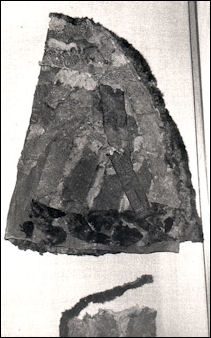
The Scythians ate sheep cooked in a pot covered by crocheted cloth. They also ate beef, horsemeat, mare’s-milk cheese, beans and used olive oil. They had no agriculture. Hunters killed snow leopards, geese, hares, wolves, lynx and reindeer with bows, arrows and javelins. With wood in short supply Scythians often used bones to make their fires. Some animals were cooked in their own ‘paunch’.”
The ancient historian Ephorus wrote: "Some of the Scythian nomads...fed only on mare's milk. Tombs have yielded silver cups used to drink koumiss and amphorae for wine. The Greeks drank their wine cut with water, They referred to Scythian-style as drinking it straight and undiluted. During an important brotherhood rite warriors drunk wine mixed with their own blood and swore lifelong allegiance to one another.
The Scythians were also reportedly quite found of marijuana. Herodotus wrote that for entertainment they threw marijuana onto heated stones, creating "a strong aroma that no Greek burnt offering can match" and causing “the horsemen too dance and howl in their joy." In one tomb archeologists found a skull with three small holes (believed to have been drilled to relieve swelling) and a cache of marijuana to offer relief from pain in the hereafter.
Scythians wore long jackets, long trousers, and soft leather boots Warriors wore helmets, belted tunics, and ankle-high boots. If the things they wore in real life were anything like what was found in tombs they also wore gilded armor. Nomads made impotent by the constant up and down motion of riding on horseback reportedly wore women's clothing. Herodotus wrote that the Scythians took vapor bathes instead of washing.
The Greeks were really impressed by the Scythian tattoos, the mostly brilliantly colored and artistically adept tattoos of antiquity. See Pazyryk Tattoos
See Separate Article KOUMISS (AIRAG) factsanddetails.com
Scythian Art
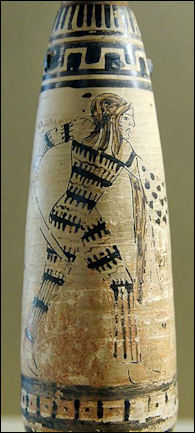
Scythians were not great craftsmen. The pottery they made was rather crude and primitive. But that doesn’t mean they didn’t appreciate good art. Plenty of good stuff has been unearthed at Scythian sites. The thing is that for the most part they didn’t create it themselves. The great art associated with the Scythians is made mostly by Greek craftsmen who lived around the Black Sea. The Scythians appeared to make a comfortable enough living from trading and plundering to purchase art from other civilizations. The Scythians became quite wealthy and were able buy a lot of art.
Much of their art was small and compact or worn. It had to be to be carried on horseback. Art objects included jewelry, decorated weapons, ornamental tent pieces, and gold objects in a variety of forms. Because their wealth had to be portable. Small decorative but strong objects made more sense than large delicate ones. Some horsemen had gold plaques the size of postage stamps sewn into their clothing.
Much of their art was on functional objects. The cheek pieces of harnesses found on horses in the kurgan in the Altai area of Kazakhstan were carved with animal figures while their saddles are decorated with gold leaf. Each horse was adorned with ornaments related to an animal commonly represented in Scythian art. A griffin sculpture was found near one horse. Ibex horns carved from wood were worn by another horse.
Most of art has been found in tombs. Like the Egyptians, the Scythians believed the could bring their wealth with them to the afterlife. The full extent of Scythian art will never be known. Most of the tombs have been looted. A few large or delicate objects such as massive stone sculptures and Greek ceramics have been excavated at Scythian sites.
Book: “Scythian Gold: Treasures from Ancient Ukraine” by Ellen Reeder (Harry N. Abrams). Reeder is an archeologist.
Images in Scythian Art
The most common motifs in Scythian art were snow leopards, eagles and stags. Most were animals that were more likely to be found in their homeland in the Altai mountains rather than animals they encountered on the steppe like wolves, rabbits and antelope. The Altai animals might have been valued because they were believed to bring luck or strength. Noticeably absent were horses.
The imagery also included griffins and horned lions from Persia and Assyria, decorations from China, Greek-style human figures and moose from Persia and Serbia. The Scythians appeared to be particularly fond of animals in combat. The animals often appeared in stylized, almost abstract, form, and included things like birds strung from antlers and hooves.
There were also few images of humans but they were often mysterious or exciting. One plaque showed a leopard eating a human head. One scabbard showed a women sitting on overturned stools. Another showed a man pulling the hair of another man.
Scythian Gold Objects
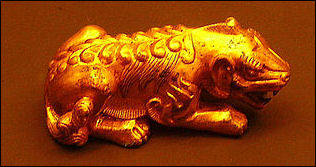
The Scythians loved gold. Scythian gold artifacts — that included finely-wrought, lifelike animals and human figures with exquisite details and wonderful filigree work — have been found from Hungary to the Caucasus. [Source: Doug Stewart, Smithsonian. Mike Edwards, National Geographic, June 2003]
Among the artifacts unearthed from Scythian tombs are a gold comb with a battle scene; a sword in a gold sheathed scabbard; gold plaques; wrought jewelry; gold headdresses; gold helmets; gold scabbards; and small sculpture showing two men drinking wine mixed with blood from the horn of a bull. A 5th century tomb near a tributary of the Dnieper River yielded a drinking cup with “six horse heads patterned in a tight, whirling hexagon, their gold reins radiating from a disk of Baltic amber.”
A 2,700-year-old tomb of a noble couple discovered in Valley of the Tsars in the Republic of Tuva revealed a treasure trove of gold artifacts. Named Arzhan 2 after a nearby village, it contained 44 pounds of gold objects, including a gold arrow quiver; a massive gold pectoral (chest ornament) that weighed 1½ kilograms; a smaller pectoral; foil fish used to decorate a horse’s bridal; and a gold-inlaid dagger. Altogether there were 5,700 pieces in the Tuva tomb. Most were small animal figures, mostly lions or tigers and some beads. Most of were sewn into clothing. The amount of gold was by far the most ever found in a Siberia tomb.
Scythian Gold Jewelry
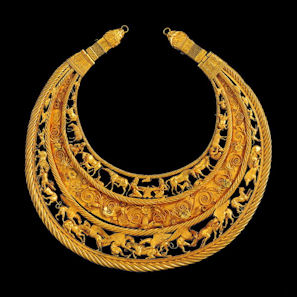
pectoral Scythians were very fond of gaudy, gold jewelry, covered with images of animals. Some headdresses and pendants made a huge racket when their wearers walked. Pieces found at the tomb in Tuva include a 3.3-pound gold pectoral (necklace); a couple of elaborately carved neck pieces, a headpiece ornament; headdress plums; a gold diadem; gold bracelets; mysterious top-hat-like gold objects; a thimble-size gold pendant with a Greek depiction of a Scythian goddess.
One of the most famous pieces of Scythian gold is beautifully-detailed, 4th century B.C. pectoral (necklace) with three rows of incredible evocative and detailed images. These include winged griffins tackling a horse, warriors making a sheepskin garment, a young shepherd milking an ewe, a mare nursing its foal, lions ripping apart pigs, deer, sheep, dogs and grasshoppers.
Other pieces of gold jewelry contain battle scenes, men hunting hares on horseback, and leopards tearing into the necks of deer. A pair of heavy golden earrings features a boat hull, with delicate filigree works and a coups dozen ducks dangling from chains.
Scythian Gold Objects and Greek Craftsmen
Many of the finest Scythian artifacts were crafted by Greek goldsmiths. Scholar have reasoned that the Scythians, by and large, were too nomadic to have the patience to sit around and learn and then practice a difficult craft.
Archeologist Ellen Reeder told Smithsonian, “It was a symbiotic relationship. The Greeks, who didn’t want to leave the cities on northern shores of the Black Sea, were happy to work with the Scythians, who didn't want to abandon their nomadic life.” The result was “a wonderful almagation.” The gold itself is believed to have come from the Urals or Central Asia or the Altai region. .
An interesting think about the gold object from the tomb in Tuva is that it is unlikely they were made by Greeks. The discovery shows that the Scythians were skilled goldsmith in their own right and they developed gold-making into a high art form before they encountered the Greeks. There is no evidence of people more advanced than them. Pazinger told National Geographic: “It’s hard to imagine that these fine pieces were made by people living in tents.” He believes they were made by some settled craftsmen in the region with the gold collected by washing gravel in mountain streams in the area.
Scythian Trade
The Scythians had trade links with Greece, Persia, Palestine and Egypt and, using Greek traders on the Black Sea as conduits, acted as middlemen between the classical world to the south and the frontier people to the north and east. From the steppe came grain, honey, furs, cattle and slaves which were traded for Greek wine, pottery textiles, olive oil, bronze mirrors, Egyptian beads, weapons and works of art.
The Scythians were not farmers but they may have controlled the grain trade around the Black Sea, where there were several Greek colonies. The Black Sea region was the bread basket of Greece. Grain exported from there kept the Greek civilization going and made the Scythians rich. The Scythians also controlled the flow of furs and timber, and perhaps slaves coming from the north.
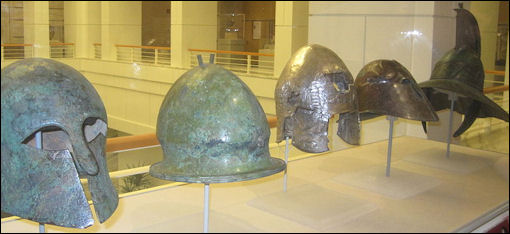
Wheat grown by Scythian vassals was shipped to Athens and the Aegean Island. "The Scythian needed the Greeks because they wanted wine, golden things, and weapons," Chernenko told National Geographic. "And the Greeks could have survived without the Scythians to buy their goods."
Deer Stones and the Western Scythian Tradition
Smithsonian anthropologist William W. Fitzhugh wrote: “Current data suggest deer stone art originated in north-central Mongolia around 3,300–3,500 years ago from an earlier tradition in Karasuk-related cultures that has not been preserved or discovered archaeologically. Earlier traditions of human-figure stelae may present in the western steppe pit-grave cultures dating to the 2nd–1st millennia BC (Chizhevskii 2009), but the direct antecedents of Mongolian deer stones remains unknown. Deer stone art and khirigsuur mound burials appears suddenly around 3200 BP and flourished for several hundred years in northern Mongolia, neighbouring Tuva, and the Altai regions adjacent to western Mongolia. To date there is no stylistic or chronological evidence suggesting a developmental sequence for either the simpler Saian-Altai or the classic Mongolian deer stone types. Given this rapid development it seems likely that deer stones and their art were transferred from an earlier medium, like wood, as suggested by K. Jettmar (1994), concurrent with introduction of metal tools. Although the Saian-Altai stones are numerically more common in Tuva and the Altai than the classic form, both frequently appear at the same sites and probably date to the same time. In Khövsgöl, some Saian-Altai stones are among the earliest dated deer stones, ca. 1300 BC, and at one site we recently excavated in Khövsgöl – Khyadag East – both types are associated with copper slag. [Source: “The Mongolian Deer Stone-khirigsuur Complex: Dating and Organization of a Late Bronze Age Menagerie”,William W. Fitzhugh, an anthropologist who directs Smithsonian’s Arctic Studies Center and is a Senior Scientist at the National Museum of Natural History /]
“Unlike Khövsgöl, which now has numerous dated deer stones at sites that include SaianAltai and Eurasian types, no deer stones have been directly dated in western Mongolia (where deer stone ritual does not include horse sacrifice), or other Tuva or Altai regions. In the latter areas, classic deer stones generally lack the artistic merit of central Mongolian stones, and they display a looser approach to classic deer stone style, as though the rigorous linguistic and organizational code that controlled style in central Mongolia relaxed, de-emphasizing the iconic deer and elaborate detailing of warrior belts and weapons. While the core elements (circle-earrings, slashes for the face, and necklace lines or pits) continue, images of animals on the main body of deer stone art begin to look more like the art found at petroglyphic sites occurring in these highland regions (Jacobson 1998; 2002; Jacobson et al. 2001; Kortum et al. 2005). Floating and free-standing images of animals replace the master deer spirit image, and weapons are shown unsheathed and ‘in action’ rather than sheathed and belted. Khirigsuurs also change, becoming more architecturally diverse, often being made in the form of fouror eight-spoked ‘chariot wheels’ (Savinov 1994; Kubarev 1979). /
“Although the date of the Saian-Altai deer stones has not yet been determined, radiocarbon dates from 2008 excavations at spoked and un-spoked khirigsuurs in the Khoton Nuur area of Baian-Ölgii, western Mongolia, both from mounds with and without horse burials, produced results of ca. 1000–700 BC, which is within the central range of central Mongolian khirigsuurs. It seems likely, however, that the Saian-Atlai deer stones may last 200–300 years later than the deer stones of north-central Mongolia, and some of the Eurasian stones may date even later, during the West Asian Scythian period. While these western stones probably continue to mark the passing of powerful warrior-chiefs, they seem to have served a more secular purpose than the classic Mongolian deer stones, for most stones lack the deer icon and shamanistic elements, and quite a few of these stones are incorporated into the eastern sides of Khirigsuur mounds. One may speculate that these shifts are linked to changes in the role of tattooed body decoration as personal protective shields and to the development of more secular beliefs and greater attention to possession and burial of material wealth seen in the Pazyryk and later Scythian burials. Nevertheless, the spread of deer stone ceremonialism across more than half the Eurasian continent suggests it accompanied a rapid population movement involving conquest and cultural transfer, a scenario that was to be repeated during the later Turkic and Mongol incursions into western Eurasia. /
Image Sources: Wikimedia Commons
Text Sources: National Geographic, New York Times, Washington Post, Los Angeles Times, Times of London, Smithsonian magazine, The New Yorker, Reuters, AP, AFP, Wikipedia, BBC, Comptom’s Encyclopedia, Lonely Planet Guides, Silk Road Foundation, “The Discoverers “ by Daniel Boorstin; “ History of Arab People “ by Albert Hourani (Faber and Faber, 1991); “Islam, a Short History “ by Karen Armstrong (Modern Library, 2000); and various books and other publications.
Last updated November 2012
